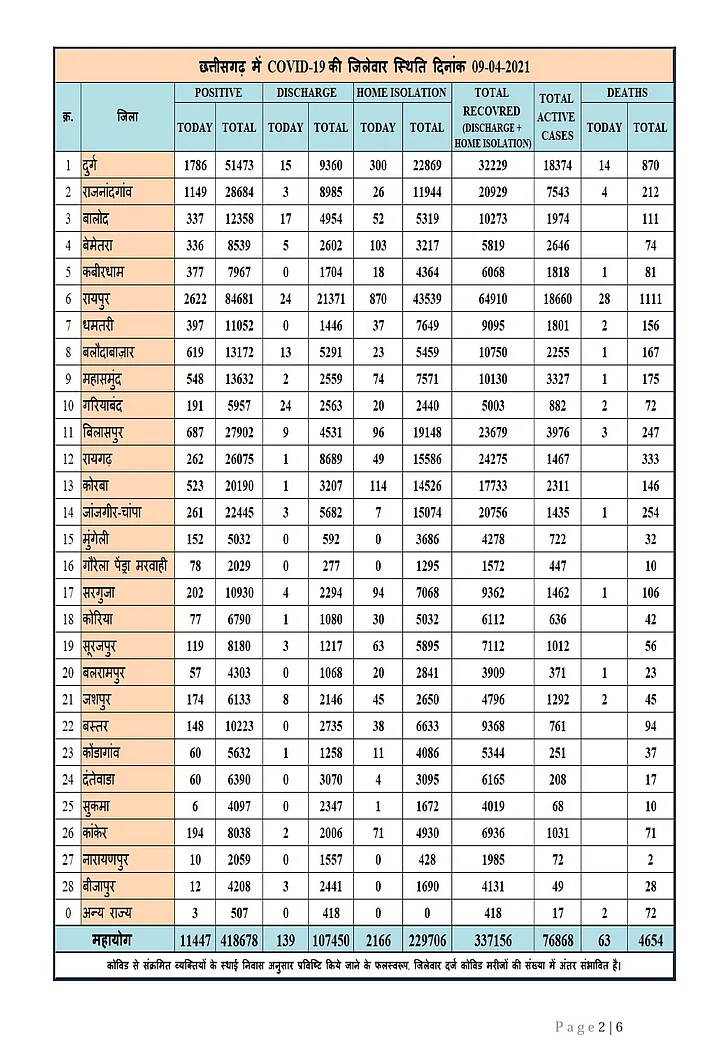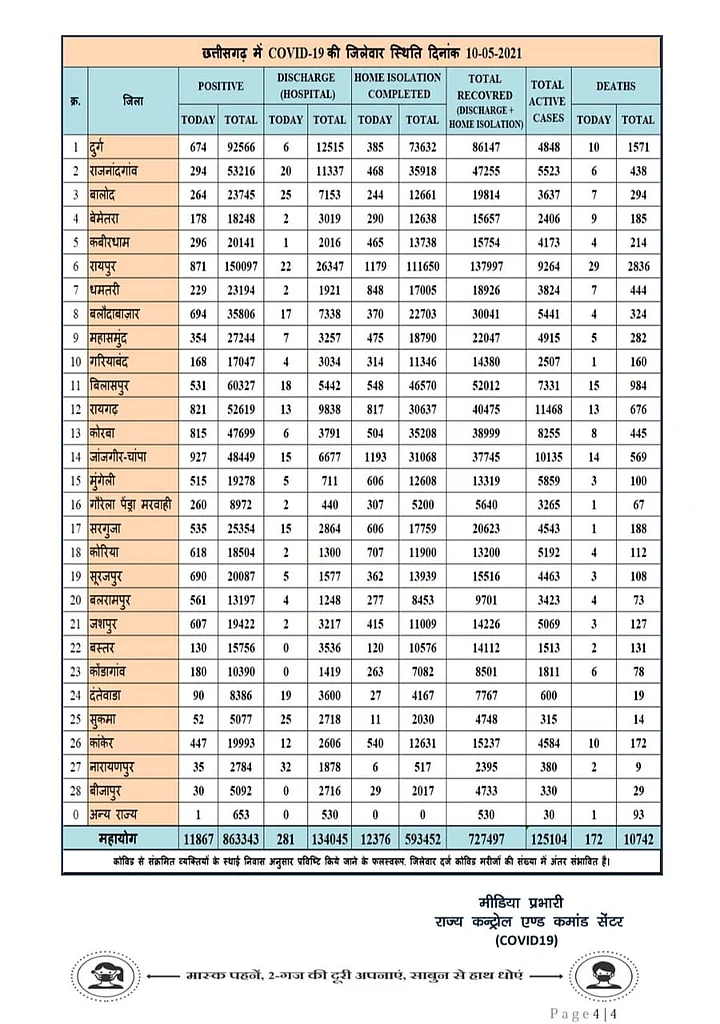Nearly 60 km from Jagdalpur headquarters kids of Bhagirathi and Santoshi Ogre woke up orphaned on Sunday, 9 May.
Bhagirathi, a teacher posted in Baastanar village of Bastar district was admitted to the hospital in the last week of April after he tested positive for COVID-19. His wife Santoshi remained at home in isolation to look after the children, aged three and five.
On the night of 8 May, he succumbed to the virus and lost his life. His wife, too, died in her sleep the same night. The situation the next morning was heart-wrenching with the kids waiting for them to wake up.
Neighbours didn’t touch the body nor did they help the children, fearing the virus while the children tried to grasp what has happened. It was hours later that the administration took note and conducted the last rites of the deceased. Both the children are now currently with distant relatives.
“People are terrified. We were helpless because we didn’t know what to do. We called the doctor who declared the couple dead, but nobody came to cremate them. The situation in rural areas is deteriorating further because we don’t have adequate healthcare facilities and there are a lot of misconceptions among the villagers.”Resident of Baastanar.
The second wave of COVID-19 hit Chhattisgarh hard. With over 10,500 deaths and more than 1.25 lakh active cases across the state. Rising cases in rural and tribal-dominant areas of Chhattisgarh have set the alarms blaring in the state.
According to state records, between 9 April and 8 May this year, districts like Gaurela-Pendra-Marwahi (GPM) witnessed an increase of 315.08 percent in COVID cases while the adjoining district of Munegli saw a spike of 263.63%. In GPM the death toll on April 9 was at 10, which skyrocketed to 67 by 10 May – a rise of 570 percent.
Similarly, tribal-dominant areas, like Jashpur and Balrampur districts, have seen a surge of nearly 200 percent in COVID cases while in most urban districts, like Raipur and Durg, the increase was 75-80 percent.
“In Chhattisgarh, where even minor health issues force people to walk long distances it is unimaginable what’s happening now that COVID is spreading rapidly. There have been media coverages where tribals are seen carrying pregnant women on their shoulders, in cot-ambulances from their villages to get medical care. You can imagine their condition once COVID second wave peaks.”Soni Sori, Social Activist
In the Maoist-infested Bastar division, Kanker district has been worst-hit by the second wave of COVID-19. The active cases in Kanker rose from 1,031 on 9 April to 4,584 on 10 May. Likewise, Kondagaon, Dantewada, Bijapur, and Narayanpur have seen a rapid increase in COVID cases over the last month.
The Regressing State of Villages
The second wave of COVID caught Chhattisgarh unprepared. Once the news of another lockdown surfaced, people started returning to their villages. Last year, migrant laborers and those coming from other states were quarantined first and were allowed to join their families after an isolation period. This time, however, there was no such system in place and experts termed this as the primary source of Chhattisgarh’s devastating situation.
Now that the situation is grave and the infection is rapidly spreading, people are worried. Instances of resistance against the vaccination drives have surfaced in multiple places across the state. People are afraid and the rumours that vaccination is deadly are doing rounds.
The rumours have spread so fast and deep that people now believe that those who get vaccinated will die and then doctors will sell off their eyes and kidneys.
“The COVID scene in villages is deteriorating fast. The information coming from remote villages is terrifying. Entire villages are suffering from symptoms similar to that of COVID and that is why the administration has asked Mitanins and ASHA workers to distribute medicines based on the symptoms,” said Anubhav Sori, a social worker from Kanker.
“There is very less knowledge among the villagers about the virus and how to handle it. They think that once they get infected, other villagers will blame them and, hence, they are averse to testing. Also, there is hardly any system in place for testing and provide proper healthcare in remote Chhattisgarh villages,” he added.
“To build life-saving systems at the village level is out of the question and not approachable at this moment. We need to check for symptoms, increase testing and shift patients to dedicated COVID-care facilities in order to save their lives. We have conveyed the same to our health staff and community hospitals.”TS Singhdeo, Health Minister, Chhattisgarh.
Along with a substandard medical ecosystem, lack of testing facilities in villages, and rampant misinformation, the issue of shortage of medical staff is a major hurdle in the state’s battle against the pandemic.
Poor Healthcare, Shortage of Medical Staff Cause for Concern
The state has a total of 1,596 posts for specialized doctors, out of which 1,359 are vacant. Of the 5,329 staff nurse positions, 1,895 are vacant, along with 989, out of 1,436, vacant posts of technicians in the state.
Sukma, a Maoist hotbed, has 28 specialized doctors posts, without even a single appointment. Similarly, at Jagdalpur’s Govt Medical College and Hospital, all eight posts of specialized doctors are vacant while 116 out of 279 staff nurse positions and 13 out of 19 technician positions remain unoccupied.
Commenting on the shortage of medical staff, the health minister said, “During BJP’s 15-year-rule there were only 279 ICU beds. We increased it to 729. There were only 1,242 oxygen beds which has now been increased to 7,042.”
“We are doing our work. All medical staffers are on the ground putting in a lot of effort, especially in the rural areas. Today, we have 477 HDU beds, 449 COVID HDU beds, there are 464 COVID-dedicated ICUs operational throughout the state. We have almost tripled the number of ventilators in the state.”TS Singhdeo, Health Minister, Chhattisgarh
Speaking on the COVID surge in rural areas, he said, “We are trying our best to restrict weddings and other social functions as these have become super-spreader events mainly in villages and tribal-dominated areas. We have faced severe deterrence in several villages against the vaccination as well as for the testing. We have asked social workers, community leaders, and NGOs to step in and help create awareness about the same.”
Vishnukant Tiwari is an independent journalist based out of Chhattisgarh. He covers Social, Stigma, Maoists, Political among other themes. He can be found on Twitter here.
(At The Quint, we question everything. Play an active role in shaping our journalism by becoming a member today.)


